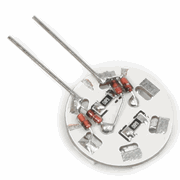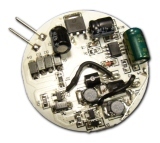Why Marinebeam?
Marinebeam was the originator of constant-current LED bulbs for marine use. Our Marinebeam bulbs use one of the most sophisticated, and efficient Constant-Current circuit topologies available. This guarantees that our bulbs are the brightest, most-efficacious, and long-lived products available today.
Our LEDs come from the world's best suppliers, like Cree, SSC, Citizen, Epistar, and Dominant. We use the best thermal substrates, and each and every bulb is thermally-engineered for the best performance and longest life. We maintain our own photometry lab and goniophometer on-site, to assure the most accurate claims for light energy, beam angles and electrical characteristics.
We have seen an explosion of products coming out of China that are absolutely spitting images of the Marinebeam products. Virtually all of these products are using orphan LEDs, simple resistor-controlled circuits, fiberglass substrates, and are not polarity conscious.
We don't offer the cheap and dangerous Chinese resistive products. See the video here of why we don't.
See image (at right) from one of our major "marine" competitors, versus an example of one of the more sophisticated circuits from Marinebeam (at left). Notice any components missing?
Our products  use premium bin-select LEDs from Citizen, Epistar, Nichia and SSC. Our substrates aren't inexpensive polyester printed circuit boards, but are engineered thermal substrates laminated from Alumi-core webs for high thermal efficiency. Our heat transfer compounds are the best available two-part silicones, not cheap Chinese thermal grease. We've selected the components for our chipset that have lower EMI emissions, and higher voltage spike thresholds. We could have chosen the cheaper type, but our products are meant to be used on your yacht. Our capacitor and inductors are also over-sized to protect the components. We also don't use "weak-link" single-component diode bridges, but instead use four discrete diodes sized appropriately for the application.
use premium bin-select LEDs from Citizen, Epistar, Nichia and SSC. Our substrates aren't inexpensive polyester printed circuit boards, but are engineered thermal substrates laminated from Alumi-core webs for high thermal efficiency. Our heat transfer compounds are the best available two-part silicones, not cheap Chinese thermal grease. We've selected the components for our chipset that have lower EMI emissions, and higher voltage spike thresholds. We could have chosen the cheaper type, but our products are meant to be used on your yacht. Our capacitor and inductors are also over-sized to protect the components. We also don't use "weak-link" single-component diode bridges, but instead use four discrete diodes sized appropriately for the application.
If you think you found the EXACT same bulb for less money, consider the features of a genuine Marinebeam bulb that cannot be confirmed by just looking at a picture of a copycat Chinese product:
- Are they multi-chip LEDs, or single-die Chinese LEDs?
- Are the LEDs bin-selected for matching color temperature, forward-voltage and current?
- Are the LEDs and phosphors manufactured in a class-rated cleanroom, or in somebody's basement workshop in Asia?
- Are the LEDs mounted on a PCB, or on an Alumicore substrate for heat dissipation?
- Does the circuit design consider RF interference issues?
- Is current controlled using a resistive method, or a true constant-current topology?
- Are the bulbs polarity-conscious, and if so, is the diode bridge a special design with multiple discrete components to handle frequencies above 4,000Hz?
- Have the bulbs actually been tested for CE compliance and RoHS standards, or are they emitting high amounts of RF noise, and manufactured with lead, mercury and cadmium materials?
- Have the lumen values been established using an Integrating Sphere or Goniophotometer under LM-79 standards, or are they just a guess based on the LED emitter spec sheets?
- Are they highly efficacious on a lumen/watt basis, or are they using lots of power to make little light?
- What about color rendering? Most LEDs, especially very cheap ones, have horrible color rendering (CRI). How will your nice steak dinner, or your beautiful varnish look under the harsh low CRI illumination?
Below is a completely untouched photo showing the stark difference between the quality of light emitted from a Marinebeam bulb vs. a Chinese knockoff product sold by a Singaporean website. While it looks exactly like a Marinebeam product, and has a warm white color, take a look at the difference in color rendering (the light from our bulb is on the left): If you don't understand the differences between the products, or want specific details , please refer to our technical section, or download our Idiots Guide to Marine LEDs. As usual you get what you pay for. We wouldn't add these sophisticated circuits and expensive components if we didn't think it was necessary and an added value to our products. Don't risk burning your yacht to the waterline for lack of a little education about LEDs.
If you don't understand the differences between the products, or want specific details , please refer to our technical section, or download our Idiots Guide to Marine LEDs. As usual you get what you pay for. We wouldn't add these sophisticated circuits and expensive components if we didn't think it was necessary and an added value to our products. Don't risk burning your yacht to the waterline for lack of a little education about LEDs.
We'll put our bulbs up against any competitive product (even the $40 ones), and we'll guarantee that ours are more efficient (efficacious), have longer life, and are brighter watt for watt.
We see now that a few of our competitors are claiming lumen ouputs and efficacies that are just impossible, given the state of the technology today. One is claiming a 60W equivalency from a 3W bulb. If it were true, that would be an efficacy of 220 Lumens per watt, and they should march right down to the Dept of Energy and claim the $10 million DOE L-Prize!
Caveat Emptor.
